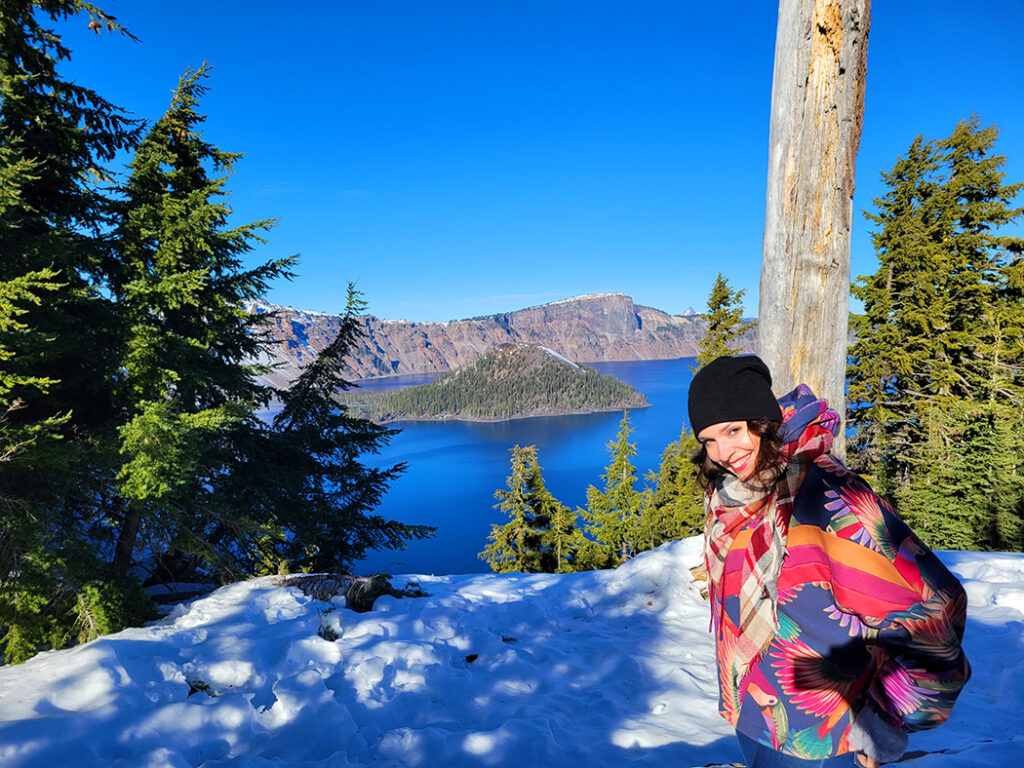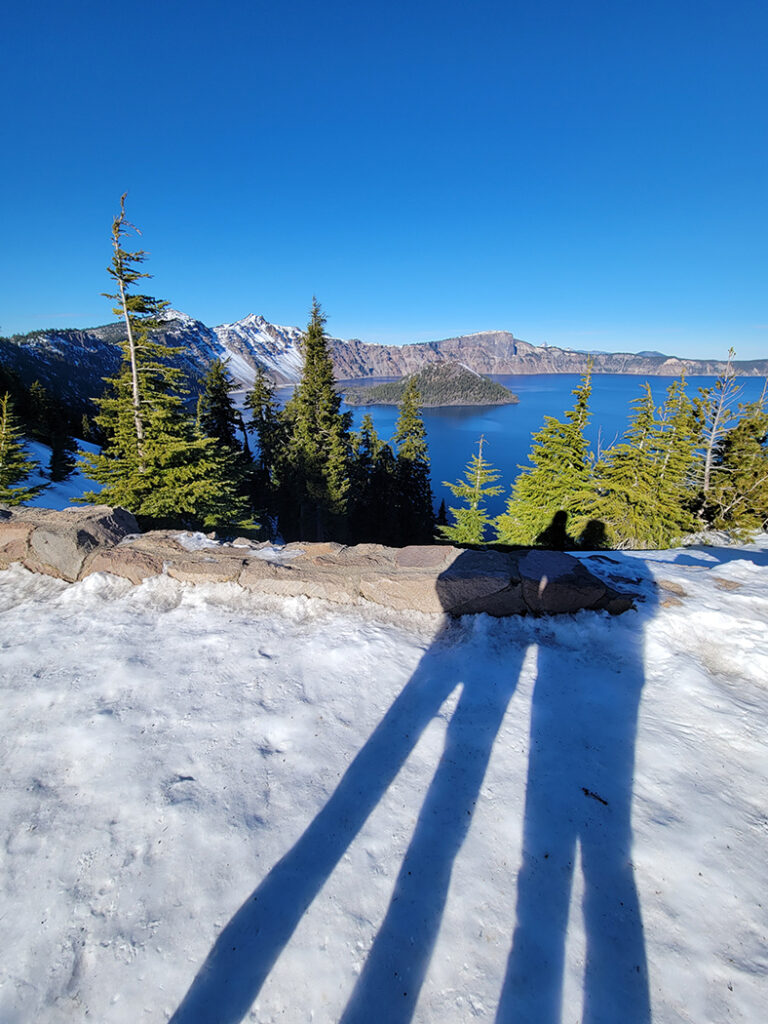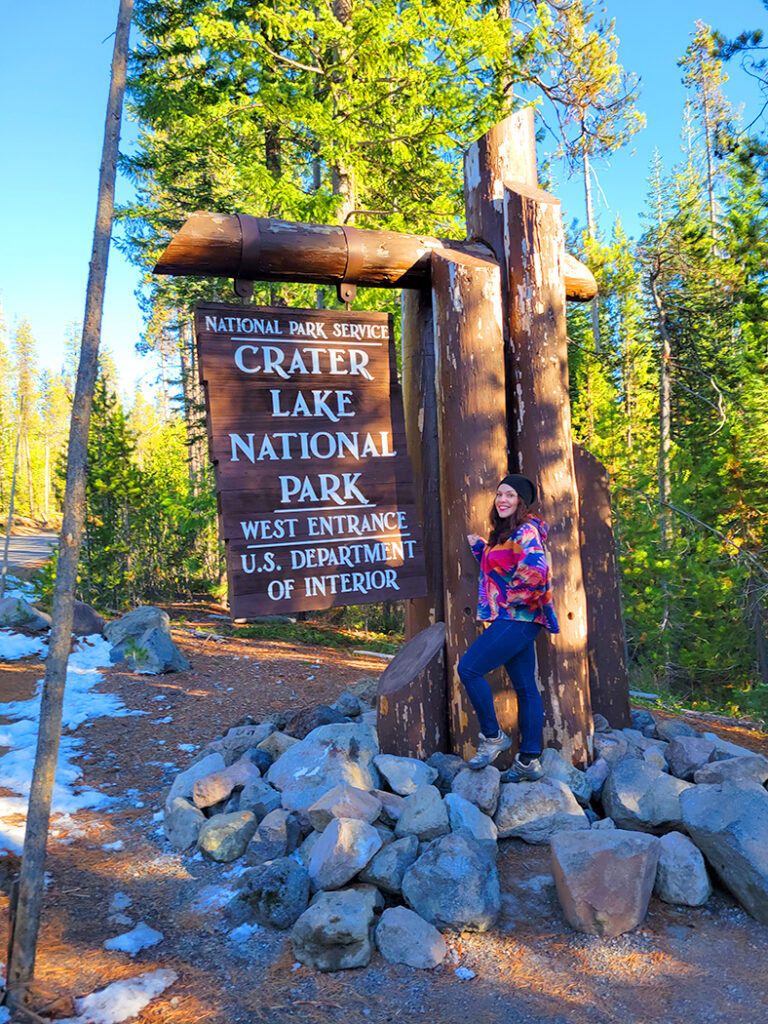Crater Lake in Southern Oregon
Crater Lake, a mesmerizing natural marvel nestled in the heart of Southern Oregon, is a testament to the forces of nature. Formed approximately 7,700 years ago within the remains of Mount Mazama, The caldera lake is the deepest in the United States and is the ninth deepest globally, reaching an impressive depth of about 1,943 feet. Its renowned clarity and striking deep blue hue result from the pristine water.

*This post includes affiliate links; if you purchase through these links, I may earn a small commission. However, please be assured that this has no impact on your expenses*
Situated in Crater Lake National Park, established in 1902 as the fifth oldest national park in the United States, the lake is surrounded by the commanding, scenic beauty of the Cascade Range. Within the park, Wizard Island, a prominent cinder cone, rises majestically from the lake’s waters, adding to the overall allure.
MESMERIZED AT 7,100 FEET
Wildlife thrives in the park, with elk, deer, bears, and various bird species calling the area home. While the lake does not support a diverse fish population due to its unique ecological conditions, it remains a haven for nature enthusiasts. Activities such as hiking, camping, and boat tours allow visitors to immerse themselves in the natural splendor.
Crater Lake’s climate is subalpine, with cold winters featuring heavy snowfall and relatively mild summers. The park remains open year-round, though certain facilities and roads may close during winter.
As we exited the vehicle at Rim Village and began walking toward the direction of the lake, we both almost fell several times on the slippery snow and ice. The hazardous terrain was well worth the incredible views. The crisp, cool alpine air filled our lungs as we stood there, taking in yet another of Mother Nature’s wonders. The sky mirrored the lake with its vibrant blue hue.
HIKING CRATER LAKE
Hiking in and around Crater Lake offers a breathtaking, immersive experience of the region’s natural beauty. The park boasts a variety of trails catering to different skill levels and preferences. These trails provide opportunities to explore diverse landscapes and enjoy panoramic views of the lake and surrounding wilderness.

For those seeking a closer encounter with the lake, the Cleetwood Cove Trail is a steep path leading to the water’s edge. Cleetwood Cove offers boat tours and a refreshing swim in the calm, cold lake waters if you’re brave enough. However, its steep trail and the challenging ascent back up should be taken into consideration.
A few other noteworthy hiking trails in/around Crater Lake:
- Rim Trail:
- The Rim Trail around Crater Lake offers breathtaking views of the blue waters and volcanic landscape. It’s accessible to visitors of different fitness levels with some paved sections.
- Garfield Peak Trail:
- This moderately challenging trail is one of the most popular, leading to the summit of Garfield Peak. Hikers are rewarded with incredible panoramic views of Crater Lake from an elevation of over 8,000 feet.
- Pacific Crest Trail (PCT):
- The Pacific Crest Trail, a long-distance trail that stretches from Mexico to Canada, passes through the Crater Lake area. Hikers can explore a section of the PCT, taking in the beauty of the surrounding wilderness.
HISTORY IS ALWAYS SIGNIFICANT
Crater Lake has a rich geological and cultural history spanning thousands of years. The story of this awe-inspiring caldera lake begins with the explosive eruption and subsequent collapse of Mount Mazama. The cataclysmic event left behind a deep caldera. Over time, the caldera filled with rain and snowmelt. This gave rise to the pristine, intensely blue waters that define Crater Lake today.
Native American tribes, particularly the Klamath people, have long regarded the area as sacred, weaving myths and legends around the creation of this majestic lake, and it is considered a sacred place in their cosmology. The lake is believed to be the dwelling place of powerful spirits. The Klamath people traditionally inhabited the Klamath Basin, an area encompassing parts of Oregon and California. They are part of the larger Plateau cultural group, which includes various indigenous peoples in the Pacific Northwest region of North America.
European-American exploration of the Crater Lake region began in the mid-19th century. In 1853, John Wesley Hillman, an early settler, became the first documented non-indigenous person to gaze upon the lake’s splendor. The establishment of Crater Lake National Park marked a pivotal moment in the area’s history. The park’s inception not only aimed to preserve the unique natural features of Crater Lake but also recognized the cultural significance of the land for indigenous communities.
Over the years, efforts to conserve the park’s ecosystems and maintain its untouched beauty have shaped its history. This ensures that future generations can continue to marvel at the wonder of Crater Lake.

AMERICA THE BEAUTIFUL
Pro Tip: The cost for a private vehicle to enter Crater Lake National Park from May 22nd to October 31st is $30.00 and is good for seven days. However, if you plan on visiting more than one national park in a calendar year, I highly recommend the America the Beautiful Pass. The “America the Beautiful” pass, officially known as the “National Parks and Federal Recreational Lands Pass,” provides access to over 2,000 federal recreation sites, including national parks, wildlife refuges, and forests.
The pass comes in various types, such as the Annual Pass, Senior Pass (for those 62 and older), Access Pass (for individuals with permanent disabilities), Military Pass (FREE for active-duty military and dependents), and Every Kid Outdoors Pass (free for fourth-grade students). For $80.00, I’ve now visited a handful of national parks, and it’s basically paid for itself and then some. Well worth all that quality time with Mother Nature, if ya ask me!
Linds
Los Angeles, California
2 Comments
Leave a Reply Cancel
This site uses Akismet to reduce spam. Learn how your comment data is processed.


Elle
December 10, 2023 at 4:40 PMWow what a beautiful place. Thanks for the great tips and historical information.
Linds
December 10, 2023 at 6:16 PMYou’re so welcome! And thank you for reading 🙂